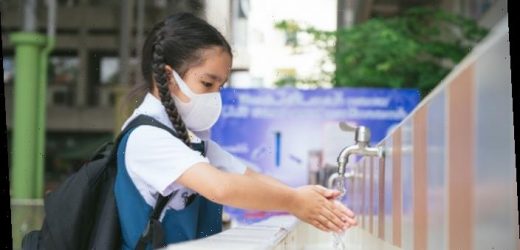IT is often said that our school days are the best days of our lives – and let’s face it, from playing with friends to enjoying face to face support from teachers, there’s more to going to school than keeping your education on track.
While parents and teachers across the UK have worked hard to adapt to remote learning, classrooms are still the best places for our children to be – which is why the UK Government is prioritising getting schools back into full service as it eases lockdown.
“There are many reasons why a return to school is important for our children’s wellbeing,” says clinical psychologist Dr Oliver Sindall, who specialises in child and adolescent mental health.
“School helps with the development of a child’s social, emotional and mental health, and provides a place for children to interact with their friends in ways that can’t be replicated online or at home.”
When schools and colleges in England fully reopen to all pupils from Monday, protective measures will include increased mask wearing for all education staff and students in secondary schools and colleges, along with twice-weekly rapid Covid-19 testing for staff and pupils aged 11 years and above.
Most importantly, parents and adults in households with school and college-age children – including childcare and support bubbles – will also be able to get two rapid Covid-19 tests per person per week.
Further to the £1 billion education and recovery package it announced six months ago, the UK Government said an additional £700 million would be spent on helping young people catch up on lost learning, including an expansion of the National Tutoring Programme for those who need it most.
To find out more information, visit gov.uk/backtoschool or speak to your child’s school or college.
’Teachers and children are excited’
Kate Jefferson, 33, who is head teacher at primary school Millbank Academy in Westminster, supports the Prime Minister’s aim to return all students to the classroom from Monday.
“There are two sides to the return to school: the academic side, and children’s mental health and wellbeing. They have to return to the classroom to learn, but also to socialise and access opportunities like playing sports or instruments.
“Some children will also have suffered with mental health issues over lockdown, experiencing loneliness and boredom because of the separation from their peers.
“We’ve partnered with experts, including organisations such as the Anna Freud Centre, to help us tackle that in a really constructive way.
“They counsel children one to one where they have specific needs, and we also have a mentor in school who’s in the playground at breaktime. She’ll play a key role in helping children find resolution to disputes, and rebuild those friendships that they’ve lost during lockdown.
“In school, we’re best placed to give children lessons focused on mental health, allowing them time to talk through and share their experiences.
“During our first week back, we’ll be having an extra lesson of PSHE every day, focusing on re-establishing routines and boundaries, and making sure children feel comfortable and can decompress after the stress of lockdown.
“Everyone wants this transition to be as positive as possible, and we have been planning for months to minimise any risk. We’ve already got protective measures in place, including staggered break times and extra cleaning staff on site during the day in high traffic areas.
“We’ve had no group gatherings, so we only have virtual assemblies. And we’ve been advising all parents to make space at the school gates.
“On our return, things will be a bit different, as new UK Government legislation means teachers and staff will be wearing face coverings a lot more inside school, where social distancing is not possible, and they will be tested for Covid-19 twice a week.
“Additional testing is also available for adults in households, support and childcare bubbles of staff, and parents and carers of school pupils and college students.
“The children of key workers, who we have continued to have in school throughout lockdown, have been very excited about their friends coming back to join them.
“The teachers are excited to have the children back, too – schools have got much better at teaching online, but it can’t beat face-to-face tuition.
“Perhaps one positive that will come out of the pandemic is that parents will have seen just how hard teachers work to support and protect their children.”
‘Our priority is making sure we are all protected’
Enass Al-Ani, 44, is the principal at secondary school Small Heath Leadership Academy in Birmingham. When it comes to children’s wellbeing, she believes remote learning is no match for attending school.
“The announcement that schools will fully reopen to all pupils is great news. During lockdown, we’ve been open for vulnerable students and the children of key workers, but for all other students, learning has happened online.
“We’ve done our utmost to ensure they’ve benefited from high-quality teaching, while keeping a close eye on their wellbeing. But there’s absolutely no substitute for the buzz of being in school.
The schools testing plan
Also for parents and adults in their households and bubbles.
Up to 1 in 3 people who have Covid-19 have no symptoms and could be spreading it without knowing.
Rapid testing is a fast and easy way to find out if you have coronavirus. It’s free and takes around 30 minutes.
It’s a simple rapid lateral flow test – a swab to the nose and/or throat.
On returning, secondary school pupils and college students will take three rapid tests at school to learn how to do them and then continue to test themselves at home with kits they will get from school.
If you are a parent or adult in their household, childcare or support bubble, you can get tested too. You can either get an assisted test at work, if it is available, attend a test site or pick up test kits to do at home. Where these are not possible, there will be a small supply of tests online for people who need them the most.
The more of us who take these tests and report our results, the sooner we can get back to a more normal way of life.
Find out how to get a free regular rapid test at gov.uk/coronavirus
“Remote teaching can’t replace those friendships, conversations, interactions with teachers, time in the playground and extracurricular activities. It’s vital children get that whole experience.
“We know children are resilient – they’ll bounce back, I’m sure. But when school fully reopens our focus will be on their wellbeing, and we will continue to provide extra support for the foreseeable future.
“We want children to be happy about being back – for them to reintegrate into our school community and re-establish their friendships – so we’ll support this by focusing on providing trust and support first.
“Once they’ve settled in, we will ensure any gaps in learning are addressed. We’ll do extra assemblies, offer rewards to students, and have lots of posters everywhere welcoming everyone back.
“Our priority is making sure students, staff and parents are well and protected.
“We’ve developed good routines around handwashing, ventilating our premises and bubbles, alongside staff and pupils wearing masks in areas where social distancing can’t be maintained – all the measures recommended by the UK Government.
“We’re also asking parents to allow their children to take Covid-19 tests at home. We were lucky enough to be part of the pilot of Covid-19 testing, and testing is now available for students’ parents, households and childcare bubbles.
“The tests are really simple to use, and don’t hurt at all. I’m hoping everyone will take part.
“During lockdown, we asked our students how we can improve, and one of the responses we’ve had the most is: ‘Open the school to all pupils.’ They’re so excited to be coming back.”
Source: Read Full Article







